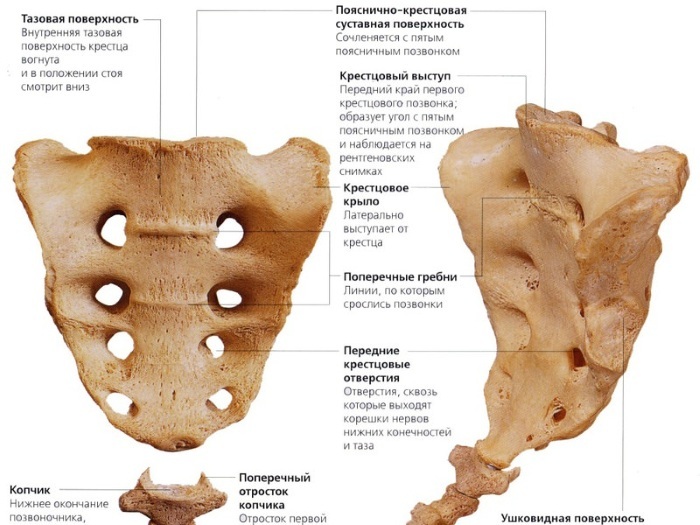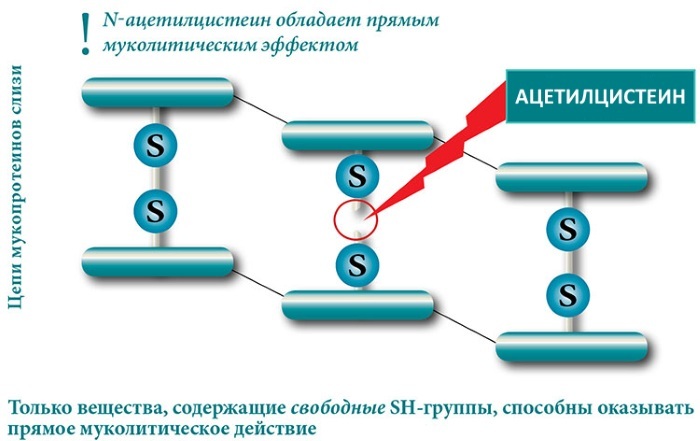Content
- Signs and stages of toxic gas exposure
- How household gas poisoning occurs
- Carbon monoxide poisoning
- Carbon dioxide poisoning
- Mercury vapor poisoning
- Exhaust gas poisoning
- Poisoning with other gases
- General rules for first aid for gas poisoning
- The use of antidotes for gas poisoning
- Subsequent treatment and period of intoxication
- Gas poisoning video
Poisonous gas poisoning requires emergency medical care, since there is a threat to human life, up to and including death. The reason is various circumstances, including a loose connection of gas pipes in the room, an incompletely closed supply to the stove, or disrupted operation of gas equipment. In some situations, people deliberately release gas into the room. It is most dangerous to get poisoned at night, when a person does not hear the smell. In such a situation, death occurs.
Signs and stages of toxic gas exposure
The effect of poisonous gases on the human body is difficult to notice right away. Acute signs of a pathological condition appear quickly if the volume of the inhaled substance is large. With a low concentration of toxic gases, symptoms appear slowly.
In medicine, certain stages of poisoning with poisonous gases are distinguished:
| Name | Description |
| First degree: easy | Intoxication of the body is to a small extent accompanied by dizziness, weakness in the body. The person wants to lie down. In some situations, chest pain occurs. With a mild degree of poisoning with poisonous gases, the victim can independently leave the room and go to the hospital for help. |
| Second stage: medium | A dangerous condition in which symptoms of mild poisoning appear. The human condition deteriorates sharply, and gradually more serious clinical signs appear. This is a lack of coordination of movement, confusion and a rapid heart rate. |
| Stage three: severe poisoning | In this situation, the victim loses consciousness. There is a high likelihood of pulmonary edema, and the brain and heart are also affected. |
| Stage four: instant poisoning | The person loses consciousness. He takes a few breaths and suffers from asphyxiation. A dangerous form of poisoning with poisonous gases, since the death of the victim quickly occurs. |
Sometimes poisoning with toxic substances occurs gradually and clinical symptoms in a person do not appear immediately.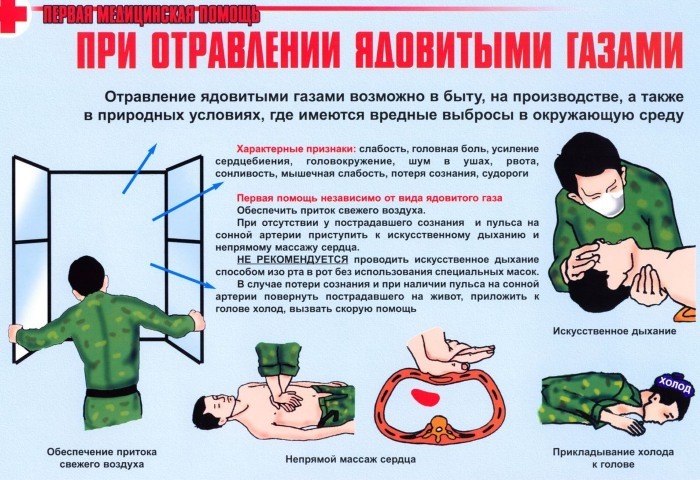
As the pathological condition progresses, the following general symptoms appear:
- dizziness and nausea;
- tinnitus, lethargy;
- pain syndrome in the area of the eyes and respiratory organs;
- cough;
- hallucinations, impaired consciousness;
- arrhythmia develops, the risk of cardiac arrest increases;
- breathing is disturbed;
- diarrhea occurs;
- there is an involuntary relaxation of the muscles of the anus and the sphincter of the bladder;
- when poisoning with hydrogen sulfide, a metallic taste appears in the mouth;
- convulsions occur.
In some situations, when poisoning with poisonous gases, a specific smell is emitted from the victim. Severe intoxication of the body leads to the fact that a person falls into a coma or dies from suffocation.
How household gas poisoning occurs
Poisonous gas poisoning occurs more often when inhaling gas-containing air.
Household gas intoxication occurs as a result of the following reasons:
- use of faulty gas equipment in the room (cylinders, pipes, stove, ventilation);
- non-observance of safety measures during the operation of gas equipment;
- intentional implementation of a gas leak;
- systematic inhalation of toxic fumes at work.
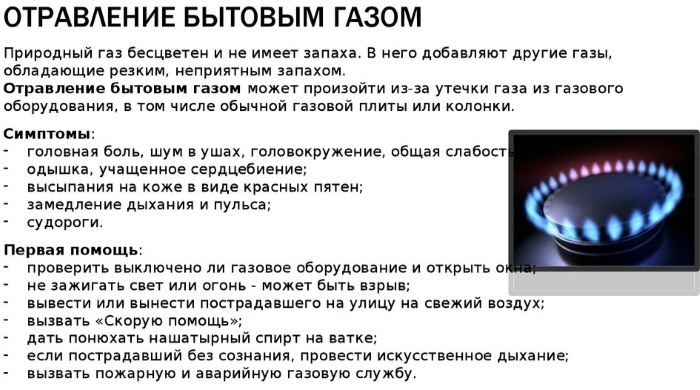
In case of mild intoxication, the victim can independently go to the hospital for help. It is important not to refuse treatment, since even minor poisoning can lead to consequences.
Carbon monoxide poisoning
Carbon monoxide is dangerous to human life because it is odorless and colorless. It is impossible to identify it. He is able to penetrate various obstacles, even through a respirator.
Hemoglobin is present in the body, which helps transport oxygen to other tissues and cells. When carbon monoxide enters the human body, it binds blood cells and damages red blood cells. Pathological processes provoke oxygen starvation, when internal organs, tissues and cells do not receive oxygen. Carbon monoxide poisoning is life-threatening because severe injury can result in death.
The pathological condition is accompanied by the following clinical symptoms:
- there is nausea and vomiting;
- the person is dizzy;
- heart rate is disturbed;
- disorientation in space is observed.
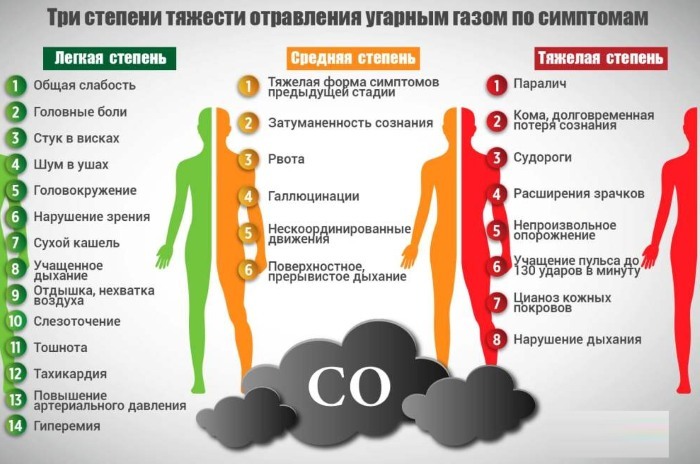
Confused consciousness is accompanied by euphoria. In some situations, a person loses consciousness.
Carbon dioxide poisoning
Carbon dioxide (carbonic anhydride) itself is colorless and has a slightly sour taste, heavier than air. The high concentration of this gas binds hemoglobin, which carries oxygen to the tissues and cells of the human body. Its excess leads to the development of hypoxia or anoxemia.
Poisoning with gases of a toxic nature is accompanied by certain symptoms, the intensity of which depends on the degree of damage to the body and the amount of intake of chemicals:
| Name | Symptoms |
| Light poisoning |
|
| Medium severity |
|
| Severe intoxication |
|
 Without emergency help, in case of carbon dioxide poisoning, paralysis of the center, which is responsible for the respiratory organs, occurs. The likelihood of cerebral hemorrhage and the onset of myocardial infarction increases. In 60% of cases, human death occurs.
Without emergency help, in case of carbon dioxide poisoning, paralysis of the center, which is responsible for the respiratory organs, occurs. The likelihood of cerebral hemorrhage and the onset of myocardial infarction increases. In 60% of cases, human death occurs.
Mercury vapor poisoning
Mercury is a heavy metal that is not absorbed by the cells of the human body. If it enters the victim's body, a small amount is excreted on its own with urine or feces. At the same time, clinical symptoms are minimal or completely absent.
Severe mercury vapor poisoning is distinguished as follows:
| Name | Description |
| Acute intoxication of the body | Mercury vapor poisoning occurs quickly and is accompanied by pronounced symptoms:
|
| Chronic poisoning | Intoxication of the body is accompanied by a gradual increase in clinical signs. In this case, internal disorders arise. |
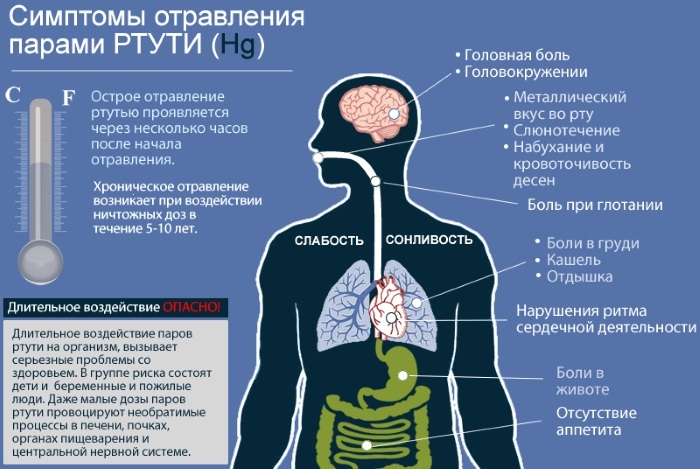
In the absence of timely medical care, a person develops pneumonia, followed by a coma and death of the patient. Mercury vapor poisoning disrupts the functioning of the central nervous system, there are problems with coordination and fine motor skills. The kidneys and organs of the digestive system also suffer.
Exhaust gas poisoning
The exhaust gases are odorless and colorless. They contain a large amount of chemical compounds that are formed during the combustion of automobile fuel. Dangerous to human life are carbon monoxide, hydrocarbon mixture, nitrogen oxide and heavy metals.
Poisoning with poisonous gases in this situation is accompanied by the following clinical symptoms:
- dizziness, nausea;
- headache;
- dry cough;
- drowsiness;
- shortness of breath and tightness in the chest;
- vision deteriorates;
- clouding of consciousness is observed;
- heart rate increases;
- the skin turns pale.
Severe exhaust gas poisoning is accompanied by hallucinations, seizures, loss of consciousness, impaired coordination and even death.
Poisoning with other gases
Chemical poisoning is also life-threatening. Intoxication of the body in such a situation occurs due to the use of certain household chemicals or medicines. The same applies to paints and varnishes, chemical compounds with which many people work in production. The clinical picture of poisoning with chemicals depends on the degree of damage to internal organs and the method of ingestion of harmful substances into the human body.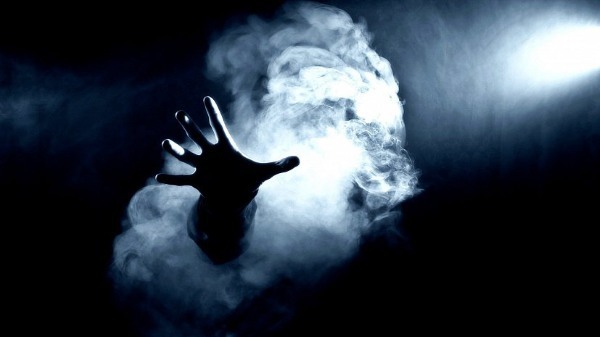
| Name | Symptoms |
| Respiratory system damage |
|
| Lesion of the esophagus |
|
| Skin lesions |
|
Intoxication of the body with poisonous gases through the skin is no less dangerous than the ingress of chemicals into the nose or mouth. Acid or alkali not only burns the skin or mucous membranes. Chemicals enter the bloodstream, spread through it throughout the body, affecting internal organs.
General rules for first aid for gas poisoning
Poisoning with poisonous gases requires emergency measures. First of all, you need to call an ambulance. Specialists will carry out all the necessary resuscitation actions.
While the medical team is driving, the victim should be given first aid, adhering to the following algorithm:
- The person must be taken out or taken out to fresh air.
- In the room, open all windows and doors for ventilation, create a draft.
- Lay the victim on a flat surface.
- Apply a cold compress (ice or wet towel) to the patient's head.
- On the human body, loosen, unfasten clothes so that he can breathe freely.
- If the victim is conscious, it is important to give him clean water to drink.
- In case of impaired consciousness, bring a cotton swab to your nose, pre-moisten it with ammonia. Such actions will help bring the victim to his senses.
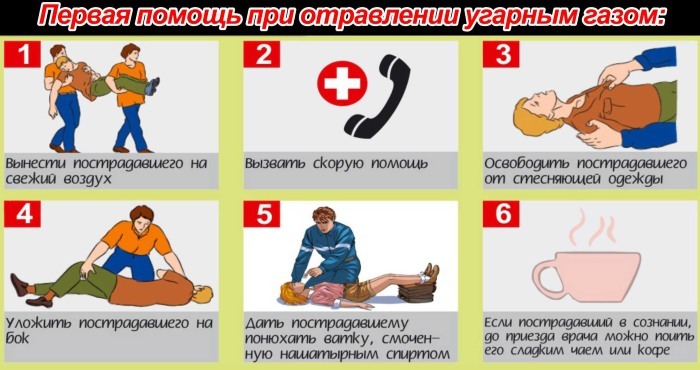
While the ambulance is going, it is necessary to maintain contact with the injured person so that he does not lose consciousness. Talk to the patient, do not let him sleep. While in the room, you cannot turn on the light or light matches, a lighter. Such actions can provoke an explosion or fire.
In case of poisoning with poisonous gases, giving first aid to a person, you may need chest compressions or artificial respiration. It is important to inhale air through the nose, and put a wet handkerchief on the mouth to prevent poisoning of the person who is performing the action. The forecast for the future and life of a person depends on the speed and effectiveness of the first aid provided.
The use of antidotes for gas poisoning
In case of poisoning with poisonous gases, antidotes are used. Medicines that break down chemical compounds that cause intoxication of the human body. The active ingredients contribute to the combination of hemoglobin with oxygen, as a result of which the toxic effect on cells is reduced.
| Name | Application | Contraindications |
| Acizol | The medicine is injected intramuscularly. The dosage of the drug for adult patients is 1 ml 2-4 times a day. On average, the course of therapy lasts 7-10 days. |
|
| Atropine | The drug is administered intravenously or intramuscularly, depending on the person's condition. The adult dosage is 2 mg.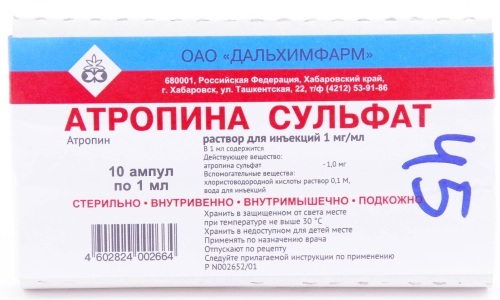
|
|
| Unitiol | The drug is mainly administered subcutaneously or intramuscularly. The dosage of the drug depends on the degree of intoxication and the type of poisoning of the body. Adults are prescribed 250-500 mg 3-4 times a day. Every day the number of injections is reduced. Treatment lasts 6-7 days until the symptoms of intoxication completely disappear. |
|
The dosage of the drug is selected taking into account the severity of the poisoning of the human body with poisonous gases. If a person cannot breathe on their own, doctors perform a tracheotomy, connect the patient to a ventilator.
Subsequent treatment and period of intoxication
Poisoning with poisonous gases requires complex therapy, which is carried out in an inpatient department. Specialists examine the patient, prescribe an instrumental examination to assess the functioning and condition of internal organs. Also identify damage and determine the degree of damage to the body by poisonous substances.
After emergency therapy, an individual treatment regimen is selected for the patient, which will help to completely get rid of toxic substances and remove them from the body.
Patients are prescribed the following medications:
| Drug group | Name | Application |
| Anti-inflammatory drugs | Pulmicort, Budesonide | Medicines eliminate the inflammatory process in the area of the respiratory organs. During the period of exacerbation, the drug is prescribed for adult patients at 1-2 mg per day. The maintenance dosage is 0.5-4 mg. The minimum course of treatment lasts 10 days. |
| Anticonvulsants | Levodopa, Amantadine | The drugs reduce spasms and muscle tone. The tablets are taken orally, swallowed whole. Adult patients are prescribed a minimum dosage, which is gradually increased. It is 0.25-1 g 2-3 times a day. Every 2-3 days, the dose is increased by 0.125-0.75 g in the absence of side effects. Cancellation of the drug is carried out gradually. |
| Pain relievers | Novigan, Aspirin | Medicines relieve the patient's condition by reducing pain. Patients should take tablets 4 times a day. The adult single dosage is 2 tablets. |
| Sorbents | Polysorb, Enterosgel | Medicines neutralize toxins and cleanse the body. The drug is diluted with water (0.5 tbsp.) Before taking. The adult dosage is 0.1-0.2 g per 1 kg of body weight per day. It is preferable to take the medicine before meals for 1 hour. The duration of therapy lasts 3-5 days. In difficult situations, 10-14 days. |
Additionally, patients are prescribed vitamin-containing drugs that destroy carboxyhemoglobin and improve the general well-being of the victim (Carboxylase). In addition, the patient can be shown physiotherapy procedures that will help restore the functioning of the respiratory system and prevent complications.
Poisonous gas poisoning requires medical attention without fail. Even a small amount of chemicals that enter the human body have a detrimental effect on its work. Many patients, after successful treatment, still notice a deterioration in their general condition. Therefore, even mild forms of poisoning with toxic substances cannot be ignored.
Gas poisoning video
Signs of carbon monoxide poisoning:


